In addition to Koyasan’s sacrosanct stature in the world of Buddhism, many of the temples in the mountain city offer room and board to pilgrims, a nice boon considering how relatively inaccessible the city is – by Japanese standards anyway – and a large part of what drew us to the tiny mountain hamlet.
We knew from talking to friends (hi L’Ell!) and reading around that a stay at a ryokan is a bit of a requirement for any visit to Japan, assuming the visitor wants an intensely unique experience while in the country. We looked into a stay in several cities, but a combination of price (they are not budget friendly) and the eventual discovery of the possibility of a temple stay in Koyasan led us to decide that a pilgrimage might be a better fit for our budget and still meet our desire to dive into Japanese culture head first.
After a busy week spent sightseeing in Kyoto, the idea of heading to a mountain retreat to soak in the stillness and rarified air of the eight peaks seemed like the perfect poultice for our travel-worn bodies. After a quick train ride to Osaka, and the slightly confusing process of getting the Koyasan World Heritage pass which bundled our train, cable car and bus tickets to and from Koyasan together, we transferred to a train out of Osaka station and began the journey to and up the mountain.
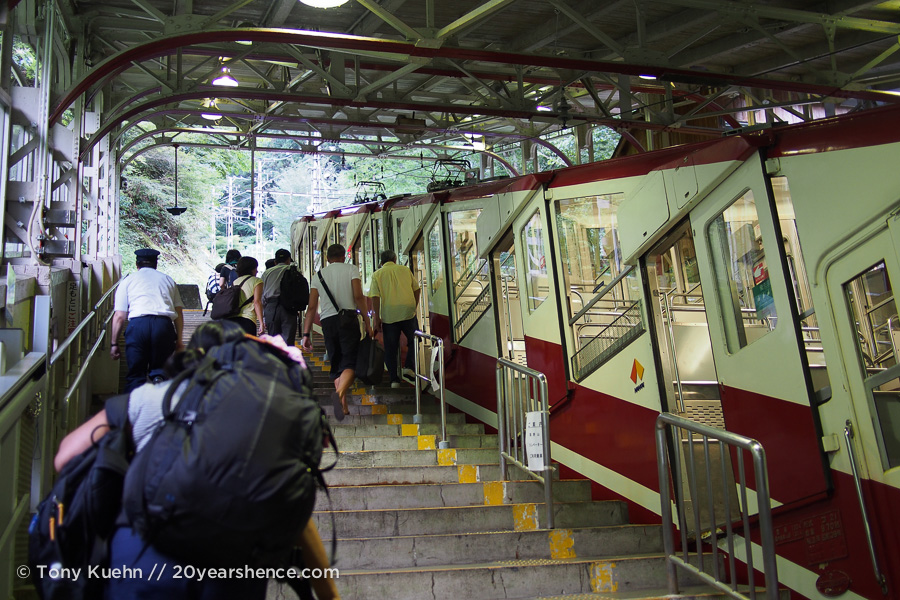
Once the ascent up the mountain begins, there are helpful little signs at every station letting you know how high above sea level you are. The further you go, the less necessary the signs become as the rails traverse the steep mountain, offering vertiginous views of the valley below.
Stepping off the train makes it immediately obvious just how special Koyasan is. As the doors slide open, a rush of cool mountain air carrying the perfume of ancient cedar trees washes across your senses and you immediately begin to appreciate the journey to valley among the peaks.

Transferring from the train to the cable car (it’s really a funicular that uses cables and pulleys rather than gears) is a short walk, and the open windows of the carriage let the breeze meander through the seats as the car begins its silent ascent. While Kukai (posthumously known as Kobo Daishi) had to make this journey the hard way, the stillness that surrounds the last part of the journey upwards encourages contemplation.

After Steph read about Never-Ending Voyage’s temple stay experience, we knew better than to go with a bargain-basement temple, and opted for a middle of the road option that had good reviews called Henjoko-in. A short (and required) bus ride from the end of the cable tramway dropped us near the temple and we went the rest of the way on foot. A note to weary travellers: if you can find the kanji name of your temple in advance, do bring it, as none of the temples have anything else out front, and counting based on the map we were given proved ineffective. We were also fooled because the entrance to our temple was one of the most beautiful we passed, and it seemed unlikely that we, mere mortals, would be allowed inside. As it turns out, we were welcome and a young monk greeted us and brought us to our room. As we walked down the vast, dim halls of the wooden building, our anticipation grew with each step.
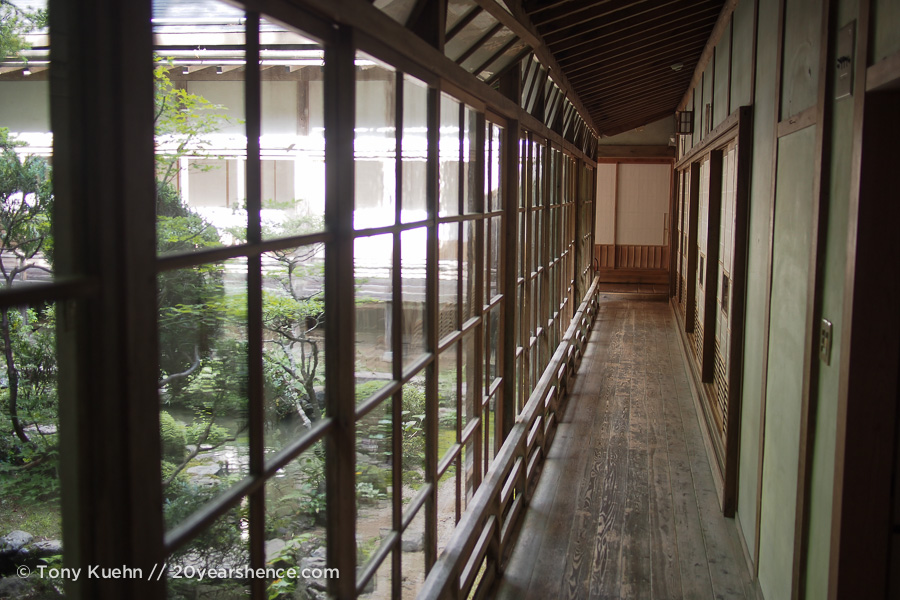
We walked down pine hallways, across panels worn smooth with the passage of thousands before us, over floors creaking in protest to our presence, past sliding doors flaking gold paint after decades of sliding to and fro, and finally down a long hallway of windows overlooking a still garden. Everywhere the smell of cedar permeated the air, enhancing the tranquility of the ancient, hulking building. The monk slid our door open and showed us inside, where we were presented green tea and some biscuits while we settled in. Using all his English skills, the monk told us about dinner, bathing afterwards and tried his best to bid us welcome.
The room was spare, though in an elegant way that signified that little would be needed for our stay, though it was, oddly, appointed with a television. Seeing that this is Japan, and it was very likely that most of the monks have cell phones stashed away in their robes, it was an unsurprising (though still slightly disappointing) reminder that, sometimes, no matter how far you go, you’re not really that far away from it all. Resolving to pay the TV no mind (easy enough to do in a country where all the programming is essentially gibberish to us anyway), we decided that it would be good to try and see some of the town before dinner, so we stashed away our things and headed out.
We walked through the city, basking in the golden rays of the fading sun as we headed toward the graveyard and the path to Okunoin temple where Kobo Daishi is entombed. We only made a little progress among the graves, however, as the mosquitos were out in force, and soon commenced to eat poor Steph alive. Beating a hasty retreat to our room and our forgotten bug spray, I resolved that I would like to try and do the walk later with a bit more cover. The graveyard seemed so tranquil, and I imagined walking through it at night would be unforgettable.
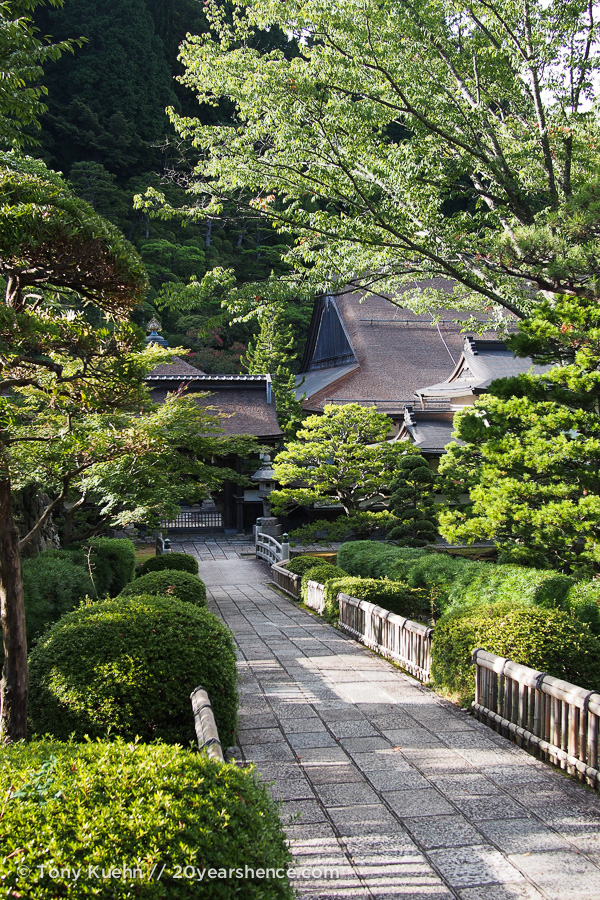

Upon our return, our appointed monk guided us to the private room where Steph & I would enjoy our humble (or so we thought!) repast. With a reputation for the ascetic, the Buddhists pleasantly surprised us with a sumptuous spread of impeccably prepared vegetarian delicacies. Subtle flavors and a wide variety of textures brought our palates to life in surprising and unexpected ways. The only disappointment was that, since it was only the two of us dining, some of our meal will forever remain a mystery, albeit a delicious one. Well and truly full, we were told that it was now bath-time.
Up to this point in our stay in Japan we had essentially avoided public baths, something most people describe as quintessentially Japanese, but also something we were simply not really interested in. We decided that it was now or never, so we donned our yukata (robes) and quickly padded down the empty hallways to the male and female bathing rooms. I slid open the door to the shower area and was disappointed to find that I would be sharing the space with an older gentleman who was about halfway through his bath. Hardening my resolve, and thanking my good graces that I am essentially blind without my glasses (and hoping, for his sake, that my companion was as well) I got down to business. Deciding not to care that I was scrubbing down in the same space as another naked person was oddly liberating. In a way it made me a little less uncomfortable with myself and also drove home the idea that really, what are my hang-ups based on? In any case, my bathing companion left and I jumped in the giant hot water tub and soaked for a bit, enjoying the perfect temperature of the water and my brief triumph over my inhibitions. While communal bathing is certainly not my first choice, I feel more prepared should we ever go to an onsen. Steph was a little more fortunate than myself, as she had the bath to herself, and reported that it was surprisingly relaxing.
Thoroughly soothed, we headed to our room where Steph tried to hide away in her freshly prepared futon while I grumbled about wanting to go out to the graveyard again, this time properly prepared. Eventually I won out, and despite her protestations Steph was a trooper and came with me.

Walking the path to Kobo Dashi’s mausoleum at night is perhaps the best time to experience the graveyard. We had the place essentially to ourselves, passing only the occasional wanderers here and there, our main company certain unknown birds calling out to one another among the tops of the cedars. Despite being the resting place of hundreds of thousands of souls, the graveyard has none of the stereotypical nighttime creepiness one normally associates with such places. Instead, the graves are blanketed in a quiet somnolence, sounds dampened by the giant trees and vast swaths of moss. At night the graves seem almost to stretch to infinity, their gray shapes mixing in the night with the silhouettes of the trees and fading into the murky depths of the forest. The path through the graves is well lit, with traditional lanterns spaced closely enough to provide light, but not so much as to spoil the ambiance.
The walk to Kobo Daishi’s final resting place is about two kilometers, and with so much to look at, it’s easy to get lost in all the little details and feel like hardly any time has passed, when in fact the opposite is true. Seemingly before we knew it, we found ourselves crossing the little bridge and entering the holiest area of the graveyard. By now it was close to 9:30pm and the grounds were devoid of any life, save our own and the ever-present invisible birds and their odd, piercing calls. It was at this moment that, for me, our nighttime walk became unforgettable.
As we walked up the stairs to the temple complex, I could see a faint glow coming from the eaves of the roof of the main temple. When we approached the building I could see that the glow was from hundreds of lanterns, hanging in rows all the way around the building, covering the underside of the roof and the upper portion of the temple in a faint, orange glow. I turned to the right, and across a small bridge there was another, smaller building. This building, set off to the side by itself, may have been smaller but was by far the more impressive of the two. Rows upon rows of lanterns hung under the wide gables of the roof, thousands of them circling the entire perimeter, suffusing the building in their orange light. None of them were very bright on their own, but together they created a beacon that shone through the darkness. I crossed the bridge, and as I did I could see through louvered windows that the building held many thousands more lanterns, all stacked neatly on rows of giant shelves filling the entire interior of the building. I stepped up to the shuttered main doorway, and peaked through the paucity of narrow openings to try and get a better view of the inside. Awash in the glow of the lanterns, my world slowly turning amber, I was certain that there could only be a very few places that could be so awe-inspiring, beautiful, and mysterious all at once. Photography is strictly forbidden on the temple grounds, and it took every ounce of restraint I had not to break the rules and take a photo anyway. Never in my life has a building had such a tangible effect on me, and my time spent gazing up into the lanterns is some of my most cherished in Japan.
After an oddly restless night, spent in comfort but with racing minds, we awoke at 6:45 a.m. to attend the morning prayers in Henjoko-in’s main hall. The room was dark, richly carpeted, and replete with sacred idols, icons, tablets and ritual instruments. The ceiling was draped with the same lanterns that we had seen at Okunoin the previous night, all lit and exuding their soothing golden light. The entire ceremony was in Japanese, as was to be expected, so we simply let the rhythm of the chanting wash over us. Steph practiced her mindfulness meditation while I tried to overcome my tired mind and aching back, letting the chant carry me where it may. The old monk then took us around the hall and spoke at length about several of the objects it contained, and we tried to appreciate the beauty all around us for lack of information. After the ceremony it was clear that many visitors had far more extensive plans at the temple, but since we are not Buddhists and didn’t speak Japanese, this part of our stay was over.
We ate another delicious meal, so quickly in fact that we didn’t even take pictures! After the meal we went back to the graveyard to give it a proper tour in the daylight. The monuments are impressive, though it is odd to see the occasional custom marker that is obviously contemporary, such as the marker of Pluto, Mickey’s dog, or the marker with the Nissan logo on it. The paths were busier during the day, and got progressively more active as we neared the temple at the end. After crossing the bridge there is a small shrine that has a heavy rock inside. It’s said that the lighter the rock feels, the purer your soul is. I was the only person I saw that was able to lift the rock, but knowing my soul as I do, I suspect that the size of my hands had more to do with it than did any purity or piety.

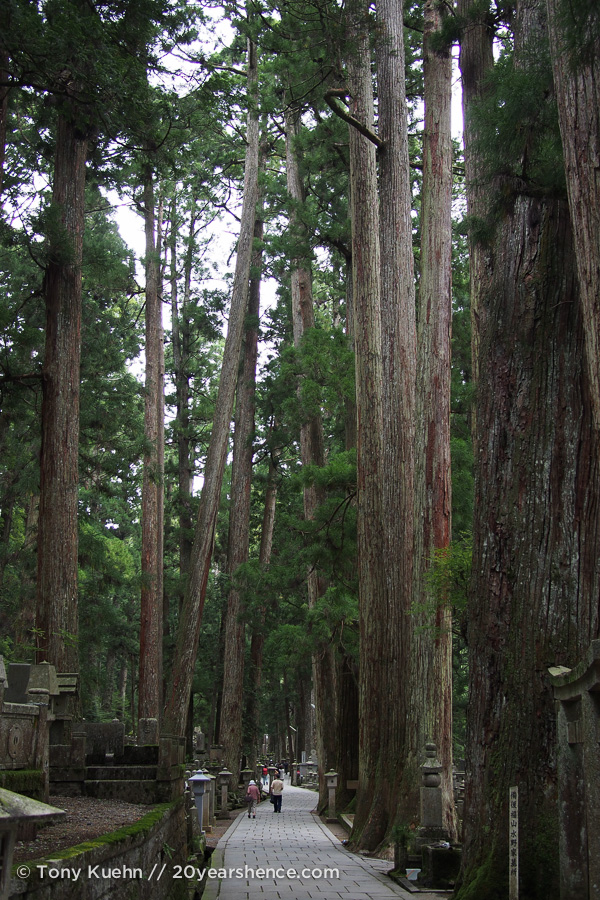

When the sun is out, the doors of the temple and the lantern house are thrown open and visitors are free to walk about. In the main hall we witnessed a Buddhist fire ceremony, where the small strips of wood with prayers written on them are burned in tall stacks, with great gouts of flame reaching high above the heads of the attendant monks. It’s easy to see how important this must be, considering the serious hazard it poses to the building and the people within. The smoke from the pine tablets, combined with the redolent fragrance of the incense was intoxicating, and we spent a long time simply observing the rituals of the temple as the monks went about their business. After making our way back through the forest of grave markers and enormous cedars, we bid farewell to Koyasan and headed back down the mountain and into Osaka.
For two such non-believers as ourselves, Nirvana was never our goal in Koyasan. Nevertheless, the chance to connect with Japan’s deeply traditional and spiritual undercurrents was incredibly rewarding and I consider our time well spent. Simply being able to have the luxury of letting our minds be free from the hustle and bustle of travel for a few days was rewarding enough. After the rather rigorous schedule we had been keeping through most of Japan, Koyasan allowed us to take a step back and examine the pace of our trip and leave a little more enlightened than when we arrived. As the cable car carried us out of Japan’s upper atmosphere and down into the reality of our trip, our daily concerns racing to meet us at the door of the train to Osaka, I felt a little more prepared to face them knowing that a place like Koyasan will always be there if I need it.
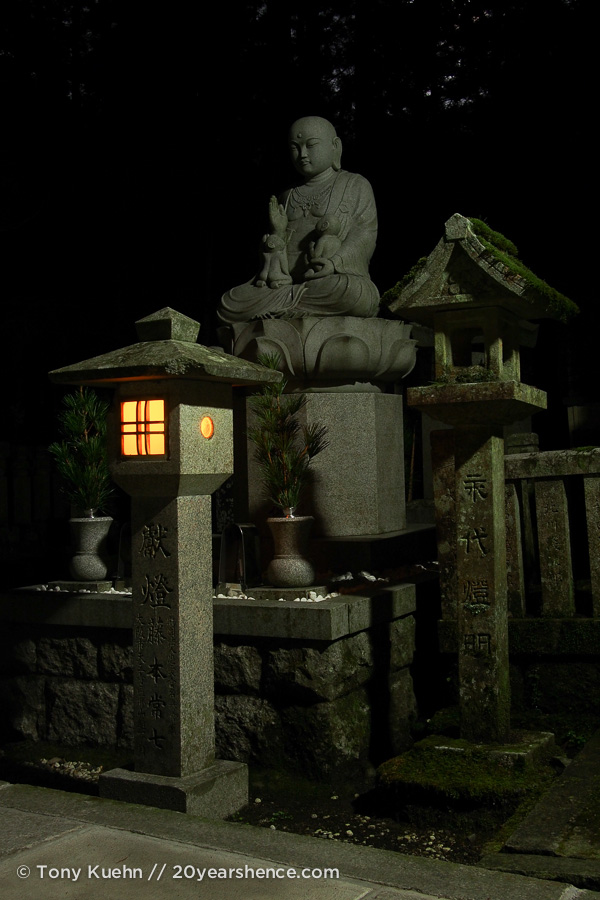
Despite my trying, I had high expectations of Koya-san and was not in the least disappointed. It was my favorite stay of our month in the country. Although not a history buff, nor religious in the least, I found it to be such a peaceful, calm, and soothing place. Walking through the graveyard at dusk, contemplating our futures, was where Jason and I finally decided it was time for us to take the next Giant Step. It will always hold a special place in my heart.
It is indeed a special place! We’re not religious either, but we definitely could feel the reverence the Japanese have for Koyasan and it was pretty remarkable to be somewhere so historically and culturally significant. I’m so glad you enjoyed it too!
Truly lovely post. Though you couldn’t photograph the moment with the lanterns, I could definitely picture it and can only imagine the serenity. What an incredible place.
Thank you! The temple was indeed amazing, I’m glad I was able to share it, even if it wasn’t my preferred method!
Wow, you two, this looks amazing! I never got a chance to stay overnight on Koya-san and only visited in the winter (which was also magical to see with snow falling on the temples). It is a special place and I’m glad you were able to fit it into your schedule! Oh, and I think that food photo labeled “tofu?” is a kind of sesame “tofu” called goma-dofu. I found the texture of it a bit weird but I remember having it at a Buddhist vegetarian lunch in Ryoanji temple.
Aha! I knew I could count on you! I think maybe Steph had an inkling as well, she is far better at recalling those sorts of things. It was very squeaky, but I did like it a lot. I can’t imagine Koyasan in the winter, I am sure it is remarkable, and frigid.
Amazing!! Loved the food photos (can you sense a theme with me and Japanese food?) – reminded me of the best meal I ever ate in Japan, at a ryokan in Gunma. Also the first time in the onsen is weird for everyone, don’t worry 🙂 You both got luckier than me – I did the sento in Tokyo and onsen in Gunma, and I have tattoos of pieces of sushi and some kanji that doesn’t make sense (thanks to the internet and my 17 year old self) so the people at the baths had a field day with me!
Thanks so much! Glad you enjoyed the food! I can only imagine your fellow bathers’ reactions, though I would think that the Japanese would be sure to find a tactful way to have some fun at your expense… unless you’re in the country, then I think anything goes, pretty much…
This is such a fantastic place! Wish I had visited this! Especially the night shots make for such a pretty picture! Thanks for sharing 🙂
You’re welcome! It was beautiful, I hope you get the chance to go one day!
Tony, you look pretty relaxed in the heathen photo. All you need is a bigger belly and a shaved head and you would resemble the old Japanese line drawings. Have a great trip.
Well, I just got a haircut here in the Philippines, so I am pretty close to the shaved head part of the equation anyway. The “barber” didn’t seem to understand what length I wanted (though he acted like he did) and as soon as I felt the first snip I knew I was in for it…
Love the idea of a temple stay – I never knew such things existed. The stories of monks with mobile phones never fail to amaze me too!
Steph, the ever-resourceful researcher found this place, as I will fully admit I knew nothing about temple stays either. It was a cool experience for sure, modernized monks or not!
I SO want to do this! Great pics. The food looks delicious. I liked Gillian @onegiantstep’s comment above too. It’s great to associate a particular place and moment with a life turning point.
Thanks! Yeah, sometimes a place is amazing for what happens inside your own head as much as the place itself. When somewhere can inspire changes in your life direction, you know it’s special!
Hmm… now I really want to know what you ate. Looks delicate and tasty!
Hey guys. We are inspired by your post, and have booked a stay at the same place you have been to. Hopefully our experience will be as good as yours. I am really looking forward to it, although Steffen is skeptical (nothing unusual there though). After our stay in an ashram in India, it will be exciting to compare. Great photos! Thanks for sharing.